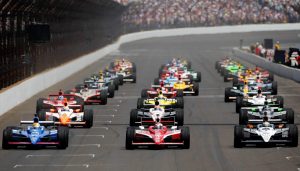NBC Sports Gears Up for Indy 500 Audio
Two weeks of testing, practice runs, races helps the broadcaster fine-tune its strategy
Story Highlights
The Indianapolis 500 provides plenty of pageantry, but that’s not the entire picture: what would open-wheel racing be without the sinuous whine of those insane engines?
NBC Sports will be picking up plenty of that sound and more on Sunday. A1 Fred Aldous will mix the race on the Calrec Apollo console aboard Indianapolis Motor Speedway Productions’ IMS HD-5 production unit, which has been the Peacock’s mainstay throughout the IndyCar season, including for the two weeks of testing, practice runs, and racing leading up to the main event. During that time, mixer Mike Pope was also on board, mixing talent and RF reporter locations, along with submixes from the track-effects mixer and the team-radio mixer, as NBC Sports fine-tuned its race-day audio strategy. One outcome was the decision that all EVS and music playback goes through the main program console as well. The HD-5 race truck will share the NBC pit box with IMSP HD-6 pre-race truck.
The pre-race truck uses a talent mic/IFB voting system, wherein all talent mics and IFBs go into a voting audio router and the “voter” sends the specific mic to the A1’s fader. For example, host Mike Tirico can travel to four locations, each using a different mic and IFB. The voter tracks his location and what microphone he is on and sends that to the “host” fader on the main console. Similarly, the voter sends the Tirico IFB to whichever IFB device is in the location that he goes to.
On Race Day
During the race on Sunday, Aldous will have six RF reporters (four in the pits, two for color-call talent), which the show will go to for analysis on teams and pit activities. SPL levels can reach over 120 dB in these areas, so pit talent use enclosed headsets offering acoustic protection. They’ll carry Sennheiser e835 hand mics, which feature high-output gain, minimal handling noise, and a tight cardioid pattern for off-axis noise rejection, feeding into BSI RF transmitters. To ensure optimal mic technique, reporters hear themselves and the interviewees in their headsets in real time.
MORE FROM INDY 500:
- NBC Sports Revs Its Engine in Inaugural Coverage
- IMS Productions Waves a Checkered Flag at Racing’s Greatest Spectacle
- BSI Puts Fans in the Driver’s Seat, on the Hood
The NBC pit box is placed at the exit of pit row, in the heart of the action. Pre-race talent will use this position along with the race talent, who will have a vantage point overlooking the length of pit row. The pit box runs on a Dante network with Studio Technologies’ Dante-enabled announcer boxes and an RTS ODIN digital intercom, which uses Dante AoIP for media transport. RTS Roameo wireless beltpacks free up the A2 and stage manager.
Rob Sweeney will handle the submix of the track effects, the in-car audio, and the general crowd ambience. He mixes this live, without any audio-follow-video, and closely aligned with how the director calls the show. Sweeney will have up to 14 in-car audio feeds, provided by BSI, embedded with the in-car video. The in-car microphones give gear change and engine-health audio feedback. When a car hits or scrapes the wall, the mics help bring the viewer closer to the action.
“Safely!” emphasizes Karl Malone, director, sound design, NBC Sports and NBC Olympics. “Calrec Hydra hubs surround the track and have a selection of ‘to and from’ mics to capture the cars as they approach as well as leave the camera shot. Sound design would normally have a car coming from the left, in the left speaker, passing to the right and out of view over your shoulder into the right surround speaker. The general ambience and roar of the track is operated using a [volume] pedal, which Rob literally leans on to fill out the soundscape when cars are in the distance. It provides the general ‘roar of hornets’ sound that permeates the Indianapolis Motor Speedway.”
The track microphones are a selection of Sennheiser shotgun mics plus Shure VP88’s. Driver/team-radio submix is handled by Jeff Feltz; driver/team-radio edit and playback, by Patrick Sellers. Feltz has 34 Motorola radio receivers with 33 cars and one with race-control frequencies dialed in for access to the team radio communication with the driver and vice versa. Mixing on a Calrec Artemis, he will shadow the action narrative that the front desk is following and listen pre-fader to the specific communications. He uses a 1.4-second delay dialed in, in which time he decides whether opening the fader adds valid information to the action on the program monitor or not.
“You must be truly ‘in the zone’ to do that job,” notes Malone, “but the value to the story of the race can be really informative.”
Sellers works alongside Feltz and records all 34 radios, via RMe MADI interface into Studio One multitrack software, and listens through each track for intriguing bits of radio communications, which he edits for potential profanity, and makes the edit clip available via rapid turnaround for the producer to decide whether to use it.
Over in HD-6, A1 Mike DiCrescenzo has multiple sets and talent for the pre/post-race shows at the Pagoda Plaza set, Pagoda Deck set, front-of-grid set, red-carpet set, and the NBC pit box. He will have access to up to 10 BSI RF stick mics and IFB systems, built by BSI, as well as to the four RF pit reporters from the main production truck.
“We are all very much looking forward to it,” says Malone. “It’s a bucket-list item for just about everyone, and, as usual, we feel very fortunate to be able to put our signature touch on it.”

